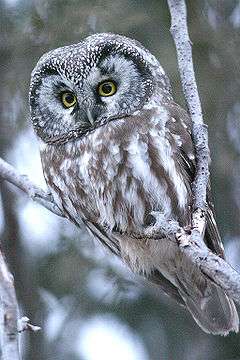Boreal owl
| Boreal owl | |
|---|---|
 | |
| Amherst Island, Ontario, Canada | |
| Scientific classification | |
| Kingdom: | Animalia |
| Phylum: | Chordata |
| Class: | Aves |
| Order: | Strigiformes |
| Family: | Strigidae |
| Genus: | Aegolius |
| Species: | A. funereus |
| Binomial name | |
| Aegolius funereus (Linnaeus, 1758) | |
| Subspecies | |
|
7, see text | |
 | |
| Range of A. funereus | |
| Synonyms[2] | |
|
Nyctala tengmalmi | |
The boreal owl (Aegolius funereus) is a small owl. In Europe, it is typically known as Tengmalm's owl after Swedish naturalist Peter Gustaf Tengmalm or, more rarely, Richardson's owl after Sir John Richardson.[2][3] The scientific name is from Latin. The genus name Aegolius is a type of screech owl thought to be a bird of ill omen, and funereus means "funereal".[4]
This species is a part of the larger grouping of owls known as typical owls, Strigidae, which contains most species of owl. The other grouping is the barn owls, Tytonidae. Due to its shyness and evasive reaction to human activities, nocturnal habits and preferred inaccessible taiga forest habitat, it ranks as one of the, if not the, least known owls in both North America and Europe.
Description

The boreal owl is 22–27 cm (8.7–10.6 in) long with a 50–62 cm (20–24 in) wingspan. It is brown above, with white flecking on the shoulders. Underparts whitish streaked with rust. The head is large, with yellow eyes and a white facial disc, and a "surprised" appearance. The beak is light yellow colored rather than dark like its relative the northern saw-whet owl.[5] The flight is strong and direct. Young birds are chocolate brown.
Behaviour
The boreal owl is an unsociable nocturnal owl.[6] Its call is similar in sound to the "winnowing" of the North American Wilson's snipe.[7][8] This species is not normally migratory, but in some autumns significant numbers move further south. It is rarely any great distance south of its breeding range, although this is partly due to the problems of detecting this nocturnal owl outside the breeding season when it is not calling.
Breeding
The boreal owl breeds in dense coniferous forests across northern North America and Eurasia, and in mountain ranges such as the Alps and the Rockies. It lays 3–6 eggs in a tree hole. Across much of Europe, and to a lesser extent in Asia and North America, naturalists and biologists put up nest boxes for these and other small owls.
Feeding and diet
This small owl eats mainly voles and other mammals but also birds as well as insects and other invertebrates. It is largely nocturnal, though in the northern most parts of its range, it is forced to hunt during daylight because of the very short nights in summer.
Mortality
Banded boreal owls have been known to live up to 16 years. Due to the owl's small stature it is often preyed upon by other owls and large raptors thus decreasing its average life span.
Subspecies
Boreal owls have seven subspecies:[9]
- A.f. richardsoni (Bonaparte, 1838): the North American subspecies, from Alaska down the Rocky Mountains and as far east as Southeastern Canada and the American Northeast
- A.f funereus (Linnaeus, 1758): nominate subspecies, from Scandinavia down south to the Pyrenees and east to the Urals, but not the Caucasus Mountains
- A.f. pallens (Schalow, 1908): from southeastern Siberia to Tien Shan in China
- A.f. caucasicus (Buturlin, 1907): Caucasus Mountains
- A.f. magnus (Buturlin, 1907): from Eastern Siberia from Kolyma to the Kamchatka peninsula
- A.f. beickianus Stresemann, 1928: from Northwest India to western China
- A.f. sibiricus (Buturlin, 1910): widespread over Siberia
References
- ↑ BirdLife International (2012). "Aegolius funereus". IUCN Red List of Threatened Species. Version 2013.2. International Union for Conservation of Nature. Retrieved 26 November 2013.
- 1 2 "Aegolius funereus". Avibase.
- ↑ Beolens, Bo; Watkins, Michael (2003). Whose bird? : Men and woman commemorated in the common names of birds. London: Helm. ISBN 0713666471.
- ↑ Jobling, James A (2010). The Helm Dictionary of Scientific Bird Names. London: Christopher Helm. pp. 33, 166. ISBN 978-1-4081-2501-4.
- ↑ Bull, Farrand (1994). National Audubon Society Field Guide to North American Birds: Eastern Region. New York: Alfred A. Knopf. p. 554. ISBN 0-679-42852-6.
- ↑ "The Owl Pages". Retrieved May 10, 2013.
- ↑ Alaska Department of Fish and Game The Boreal Owl. , Retrieved on May 10, 2013.
- ↑ "Boulder County Nature Association". Retrieved May 10, 2013.
- ↑ Gill F & D Donsker (Eds). 2014. IOC World Bird List (v 4.2). doi:10.14344/IOC.ML.4.2 www.worldbirdnames.org Accessed 25 May 2014.
External links
| Wikimedia Commons has media related to Aegolius funereus. |
| Wikispecies has information related to: Aegolius funereus |
- "Boreal Owl media". Internet Bird Collection.
- "Aegolius funereus". Integrated Taxonomic Information System. Retrieved 24 February 2009.
- Aegolius funereus in the Flickr: Field Guide Birds of the World
- "Aegolius funereus". Avibase.

- Boreal Owl photo gallery at VIREO (Drexel University)
